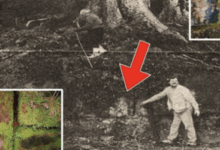Scientists Terrifying New Discovery of Amelia Erhart Changes Everything!
Amelia Earhart’s disappearance in 1937 has remained one of aviation’s most enduring mysteries, captivating the world for nearly nine decades. The pioneering aviator, who was determined to break barriers for women in aviation, vanished without a trace while attempting to circumnavigate the globe along its longest route. Despite countless theories, expeditions, and debates, the mystery of what happened to Earhart and her navigator Fred Noonan has eluded investigators for generations.
Earhart was no stranger to breaking records. By the time she embarked on her final journey, she had already made history with her solo transatlantic flight and had achieved multiple speed records. She was an icon, embodying the spirit of adventure, courage, and defiance of the societal norms that expected women to remain in the background. Her mission to fly around the world was considered the pinnacle of her career—a bold challenge that not only tested her skills but also aimed to inspire countless others to pursue their dreams.
However, on July 2, 1937, while attempting to locate the tiny Howland Island in the Pacific Ocean, communication with Earhart was lost. Her last known radio transmission was a brief message that described her position as “on the line 157 to 337,” followed by silence. What followed was one of the largest and most expensive search efforts in history, mobilizing ships, aircraft, and vast resources. But the search yielded no definitive answers, and Earhart’s disappearance soon became a subject of widespread speculation.
Over the years, numerous theories have emerged. Some believed she crashed into the ocean, her plane sinking into the vast Pacific without a trace. Others proposed that she was captured by Japanese forces, possibly held in secret for years after the crash. There was even a theory that suggested she survived as a castaway on a remote island. The absence of conclusive evidence allowed these theories to persist, fueling public fascination and keeping Earhart’s story alive in the collective imagination.
The quest to find Amelia Earhart began almost immediately after her disappearance. President Franklin D. Roosevelt himself authorized the initial search, which involved nine ships, 66 aircraft, and a budget of \$4 million—equivalent to more than \$75 million in today’s dollars. Despite the large-scale effort, nothing was found. As time passed, advances in underwater exploration technology spurred renewed searches in the 1980s, particularly focusing on the Gardner Island theory, which proposed that Earhart and Noonan had crash-landed on what is now known as Nikumaroro Island.
In the following decades, various expeditions uncovered artifacts that were believed to be linked to Earhart, including a woman’s shoe, a jar of freckle cream, and an aluminum panel. However, no concrete evidence was ever found to definitively link these artifacts to her plane. In the 1990s and early 2000s, a competing theory suggested that Earhart had run out of fuel and crashed into the ocean near Howland Island, sparking new deep-sea searches. Meanwhile, other expeditions focused on the possibility that Earhart had been captured by the Japanese, after a controversial photograph emerged that allegedly showed her and Noonan in Japanese custody.
In 2012, a new search was launched with the backing of then-Secretary of State Hillary Clinton. This expedition employed advanced sonar technology to scan a targeted area near Howland Island, but once again, it returned empty-handed. The search for Earhart continued to gain momentum as new technologies and techniques were developed, but the case remained unsolved—until 2025.
The breakthrough came not from the physical search efforts, but from a computational breakthrough that integrated a wealth of historical data. A collaborative team of oceanographers, data scientists, and aviation historians used a probabilistic model that combined information about Earhart’s final radio transmissions, weather conditions, fuel consumption, and even psychological profiles of Earhart and Noonan to predict their decision-making under stress. This model led researchers to a previously overlooked location—378 miles southeast of Earhart’s intended destination, in an area that had been dismissed due to conflicting interpretations of her final transmissions.
This site, located in the Howland Basin, contained an underwater feature where debris from the wreckage had settled. The discovery was made possible by technological advancements that allowed researchers to identify and map previously unknown underwater currents and topographical features. The site was then narrowed down using declassified military sonar data and detailed weather models from 1937, which suggested that Earhart had made an emergency heading toward an island chain farther southeast than originally thought.
Once the location was pinpointed, the next challenge was to confirm the wreckage. The search team used cutting-edge deep-sea mapping technology, including autonomous drones that could operate for weeks without resurfacing, covering vast areas of the ocean floor. These drones employed synthetic aperture sonar capable of creating high-resolution 3D images, even at depths of up to 20,000 feet. The data generated by these drones revealed an unnatural pattern of debris, which led to the identification of an aircraft crash site.
Advanced imaging and analysis techniques confirmed that the wreckage was consistent with the impact of an aircraft. The debris field stretched over 800 meters, and the larger structural components showed signs of having been scattered by ocean currents. In addition, the aircraft’s impact angle and debris distribution matched the expectations of a controlled ditching—a planned water landing executed by Earhart herself.
The critical breakthrough came with the recovery of a specific component—the starboard engine mounting assembly. This part, identifiable by its serial number, was confirmed to belong to Earhart’s Lockheed Electra, conclusively linking the wreckage to her aircraft. Other artifacts recovered from the site included the plane’s landing gear, which showed signs of compression consistent with a controlled water landing, as well as Earhart’s leather flight jacket, which had been remarkably preserved in the cold, low-oxygen environment of the deep ocean.
Perhaps most poignant were the personal items recovered, including a compact mirror and a wristwatch that had stopped at 12:42 p.m., approximately four hours after Earhart’s final radio transmission. These items provided a glimpse into the final moments of her life and painted a picture of the aviator’s determination to survive despite the overwhelming odds.
In the end, the discovery of Amelia Earhart’s aircraft not only solved one of history’s most enduring mysteries, but also revealed the harrowing final hours of a woman who, even in the face of imminent disaster, never gave up. Her final flight was not a random accident, but a calculated series of decisions made under extreme pressure—decisions that ultimately led to an emergency landing attempt that would end in tragedy.
Through the combination of modern technology, detailed historical data, and the dedication of countless researchers, the world now knows the final fate of Amelia Earhart. But even as the mystery is solved, her legacy lives on as a symbol of human resilience, determination, and the spirit of exploration.




